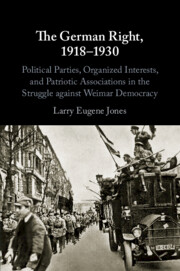 The German Right, 1918–1930
The German Right, 1918–1930 Book contents
- The German Right, 1918–1930
- The German Right, 1918–1930
- Copyright page
- Dedication
- Contents
- Figures
- Acknowledgments
- Abbreviations
- Introduction
- 1 Revolution and Realignment
- 2 Infrastructure of the German Right
- 3 Forging a Conservative Synthesis
- 4 Growth and Consolidation
- 5 The Radical Right
- 6 1923 – A Missed Opportunity?
- 7 From Triumph to Schism
- 8 Stabilization from the Right?
- 9 Paladins of the Right
- 10 A Resurgent Nationalism
- 11 The Road Back to Power
- 12 The Burden of Responsibility
- 13 From Defeat to Crisis
- 14 Reverberations and Realignment
- 15 The Chimera of Right-Wing Unity
- 16 Schism and Fragmentation
- 17 The Brüning Gambit
- 18 The September Earthquake
- Epilogue
- Select Bibliography
- Index
12 - The Burden of Responsibility
Published online by Cambridge University Press: 21 March 2020
- The German Right, 1918–1930
- The German Right, 1918–1930
- Copyright page
- Dedication
- Contents
- Figures
- Acknowledgments
- Abbreviations
- Introduction
- 1 Revolution and Realignment
- 2 Infrastructure of the German Right
- 3 Forging a Conservative Synthesis
- 4 Growth and Consolidation
- 5 The Radical Right
- 6 1923 – A Missed Opportunity?
- 7 From Triumph to Schism
- 8 Stabilization from the Right?
- 9 Paladins of the Right
- 10 A Resurgent Nationalism
- 11 The Road Back to Power
- 12 The Burden of Responsibility
- 13 From Defeat to Crisis
- 14 Reverberations and Realignment
- 15 The Chimera of Right-Wing Unity
- 16 Schism and Fragmentation
- 17 The Brüning Gambit
- 18 The September Earthquake
- Epilogue
- Select Bibliography
- Index
Summary
Chapter 12 examines the DNVP’s record as a member of the Marx’s coalition government from its initial successes from the passage of the Work Hours Law and the Unemployment Insurance Act in the spring and summer of 1927 through its failure to develop an adequate legislative response to the increasingly desperate situation in which the German farmer found himself to its awkward embrace of The Law for the Protection of the Republic in May 1927. The DNVP’s situation in the Marx cabinet was further complicated by a virtual mutiny in the Stahlhelm against collaboration with the existing system of government and a revolt in the countryside spearheaded by regional RLB affiliates RLB that were no longer satisfied with the DNVP’s defense of agriculture’s economic welfare. Increasingly desperate to salvage something of its second experiment in governmental participation, the DNVP staked everything on the passage of a Reich School Law that encountered such strong opposition from the DVP that not only was the bill rejected but the governmental coalition collapsed.
Keywords
- Type
- Chapter
- Information
- The German Right, 1918–1930Political Parties, Organized Interests, and Patriotic Associations in the Struggle against Weimar Democracy, pp. 363 - 393Publisher: Cambridge University PressPrint publication year: 2020
